Related Research Articles

Dresdner Bank AG was a German bank, founded in 1872 in Dresden, then headquartered in Berlin from 1884 to 1945 and in Frankfurt from 1963 onwards after a postwar hiatus. Long Germany's second-largest bank behind Deutsche Bank, it was eventually acquired by Commerzbank in May 2009.

Commerzbank AG is a global German universal bank headquartered at Commerzbank Tower in Frankfurt. The bank was founded in Hamburg in 1870 and is today among the largest credit institutions in Germany, with total assets of €534 billion as of the end of September 2022. With over 15 percent ownership the Government of Germany is the bank's biggest shareholder.

The A. Schaaffhausen'scher Bankverein was a bank in Cologne, initially founded in 1791. In 1848 it was reorganized as a joint stock company, the first to be legally recognised as a bank in what is now Germany. It was purchased in 1914 by the Berlin-based Disconto-Gesellschaft, and its brand finally disappeared in 1929 as the latter was in turn merged with Deutsche Bank.

Deutsch-Asiatische Bank was a foreign bank in Asia, founded in 1889 in Shanghai. Its principal activity was trade financing, but together with English and French banks, it also played a role in the underwriting of bonds for the Chinese government and in the financing of railway construction in China.

The Bayerische Vereinsbank was a German bank founded in 1869 in Munich. It developed into one of the largest regional banks in Germany, before merging in 1998 with Bayerische Hypotheken- und Wechsel-Bank to form HypoVereinsbank (HVB).

Joh. Berenberg, Gossler & Co. KG, commonly known as Berenberg Bank and also branded as simply Berenberg, is a multinational full-service private and merchant bank headquartered in Hamburg, Germany.

The Darmstädter und Nationalbank, in shorthand Danat-Bank or Danatbank, was a large German joint-stock bank. It was formed in 1922 from the merger of the Bank für Handel und Industrie (Darmstadt), known as Darmstädter Bank, and the Nationalbank für Deutschland. Its failure in July 1931 was a significant episode of the European banking crisis of 1931.

The Disconto-Gesellschaft was a significant German bank, founded in Berlin in 1851. It was one of the largest German banking organizations until its 1929 merger into Deutsche Bank.

Robert Pferdmenges was a German banker and CDU politician. He was a member of the Bundestag from 1950 to 1962 and a close friend to Konrad Adenauer.
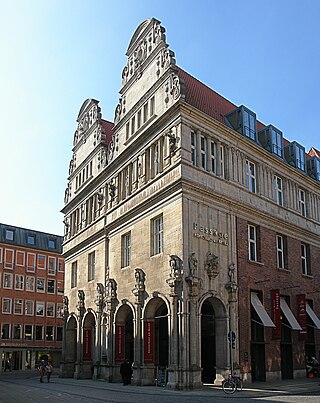
The Kontorhaus am Markt in Bremen is a historical building in the city centre of Bremen. Today, it is used as a shopping mall. It is situated at the Bremer Marktplatz between three streets: Langenstrasse 2/8, Stintbruecke 1 and Bredenstrasse 13.

The Bank für Handel und Industrie in Darmstadt, often referred to as Darmstädter Bank, was a significant joint-stock bank in Germany, active from 1853 until its merger with Nationalbank für Deutschland to form Danat-Bank in 1922.
Oscar Schlitter was a German banker. Reflecting the long-standing "hands-on" approach of banks in Germany, Schlitter was involved in several major commercial and industrial mergers. He played a leading role in the 1929 merger of the indebted German VGF company with the Dutch ENKA business, creating one of the leading European producers of rayon.

The European banking crisis of 1931 was a major episode of financial instability that peaked with the collapse of several major banks in Austria and Germany, including Creditanstalt on 11 May 1931, Landesbank der Rheinprovinz on 11 July 1931, and Danat-Bank on 13 July 1931. It triggered the exit of Germany from the gold standard on 15 July 1931, followed by the UK on 19 September 1931, and extensive losses in the U.S. financial system that contributed to the Great Depression. The crisis has been widely associated with the subsequent rise of the Nazi Party in Germany and its eventual takeover of government in early 1933, as well as the emergence of Austrofascism in Austria and other authoritarian developments in Central Europe.
Adolph Salomonsohn was a German lawyer and banker. He was a proprietor of the Disconto-Gesellschaft and influenced the establishment of the stock market in Germany.
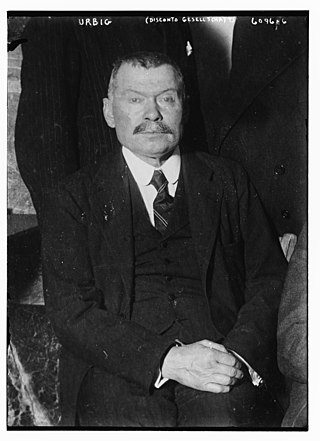
Franz Urbig was a German banker. He joined the Disconto-Gesellschaft as a trainee on 15 July 1884 and built much of his career and reputation within this bank in Southeast Asia during the final part of the nineteenth century. Between 1902 and 1929, when the bank merged with the larger Deutsche Bank, he was a partner in the Disconto-Gesellschaft. Between 1930 and his death in 1944 he was chairman of the supervisory board at the enlarged Deutsche Bank. His long career was not without controversy.

Georg Solmssen was a German banker.
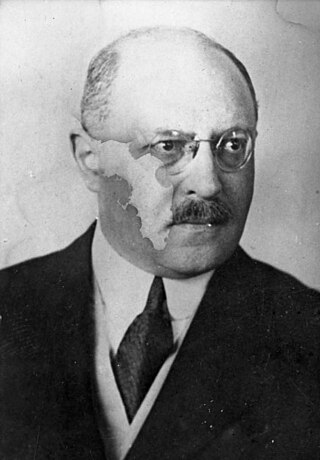
Oscar Wassermann was a German-Jewish banker.

The Bayerische Hypotheken- und Wechsel-Bank was a German bank founded in 1834 in Munich. It developed into one of the largest regional banks in Germany, before merging in 1998 with Bayerische Vereinsbank to form HypoVereinsbank (HVB).
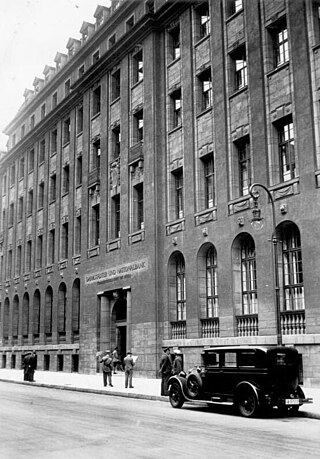
The Nationalbank für Deutschland was a significant joint-stock bank in Germany, founded in 1881 and merged in 1922 with Darmstädter Bank to form Darmstädter und Nationalbank, in shorthand Danat-Bank.
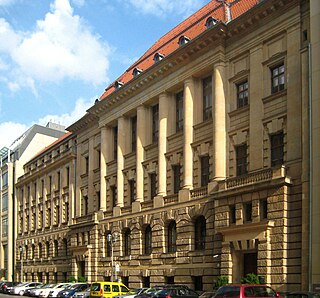
The Berliner Handels-Gesellschaft was a significant German joint-stock bank, founded in 1856 in Berlin. It relocated to Frankfurt following World War II.
References
- ↑ Michael North: "The Great German Banking Houses and International Merchants, Sixteenth to Nineteenth Century", in: Alice Teichova, Ginette Kurgan-Van Hentenryk and Dieter Ziegler (eds.), Banking, Trade and Industry: Europe, America and Asia from the Thirteenth to the Twentieth Century, Cambridge University Press, 2011, ISBN 9780521188876, p. 46
